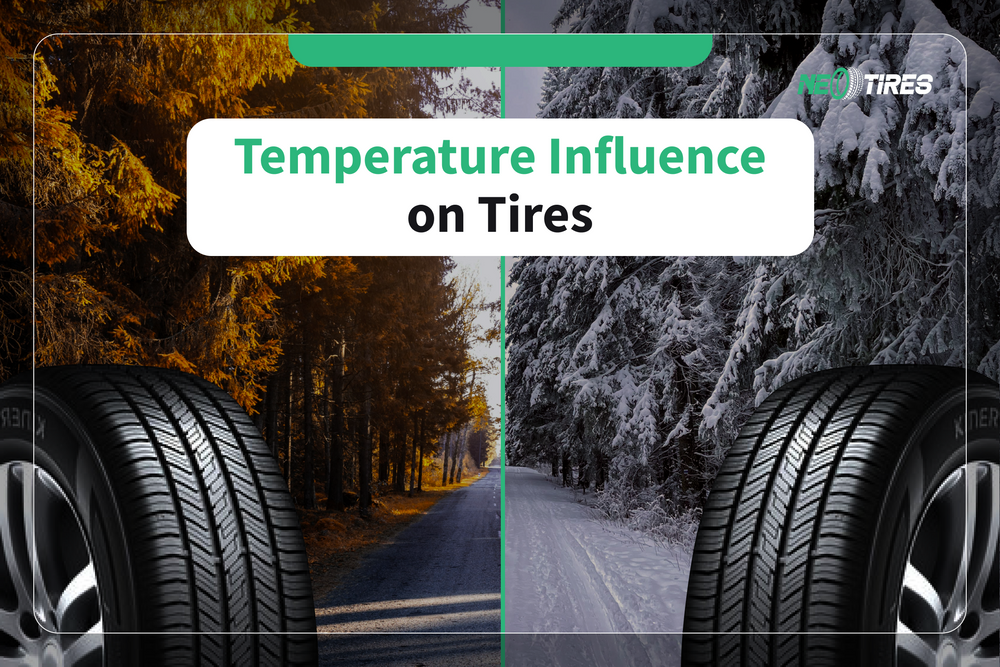You have probably heard more than once that tire pressure is somehow dependent on the outside temperature. In fact, the temperature has a lot to do with the entire operation of the vehicle, and not just with the tires. You probably remember how long it takes to warm up your car in the winter until the whole system can function properly. Not to mention that the TPMS sensors indicate pressure deviations when you actually have just adjusted the tire pressure.
Well, the temperature really plays tricks on our vehicle. And I'm here to explain how the Celsius degrees impact our tires. Believe me, once you understand the principle of operation, it will be much easier for you to understand your car.
Does Temperature Affect Tires?
Let's better understand how temperature affects the tires. The explanation can be found in the physics lesson that you probably missed when you were in college. You probably thought that physics lessons would not help you in life. But now the moment has come those lessons indeed have value.
So why does temperature matter to your tires? Let us remember that gases have the physical property of contracting and expanding depending on the temperature around them. This means that as the temperature rises, the air particles in the tires detach from each other, expanding the coverage area. As a result, they take up more volume. The same is true for the opposite scenario - the air particles contract, attaching to each other and covering less space. Thus, the air in the tires is reduced.
Let's exemplify this idea. Imagine a large room with many people in it. If it's cold in the room, people will try to hug each other to warm up. So everyone will gather in a corner while the space of the room will remain partially empty. If the temperature starts to increase, people will try to separate themselves from each other. They will prefer to sit further from each other to have enough air and somehow be cooler. Respectively, they will spread over the entire surface of the room. Starting from this premise, it becomes clear what physical process takes place in the tires during a cold day and a warm day. The TPMS sensors do nothing else than react in a panic to the changes inside the tires.
Weather Impact on Tire Pressure
Many of us think that tire pressure is the only effect that temperature generates. Tire pressure is indeed the most impacted, but it is certainly not the only aspect impacted by temperature. In this context, remember how tires don't perform well when they are not intended for the right season.
For example, if you have winter tires in the warm season, you will suddenly feel how the car performs poorly as it undergoes traction issues. This effect does not only occur due to inappropriate treads but also due to the inappropriate temperature. Tire manufacturers take into account the temperatures for which they are intended. Respectively, they add components and structures to deal with the temperatures for which they are designed. If the tires are used in other environments, they can expand or contract at the structural level, leading to improper traction.
For this reason, one of the most suitable types of tires for areas with fluctuating temperatures is all-season tires. As long as they are not exposed to extreme temperatures, they perfectly cope with temperature fluctuations without severely affecting their structure.
In conclusion, the temperature impacts not only the pressure inside the tire but also its performance. It is true that it is not a direct impact, but rather a secondary one. However, the most correct thing is to follow the manufacturers' recommendations regarding the type of tires we wear, so that they coincide with the temperatures for which they were designed.
How Much Does Temperature Affect Tire Pressure?
You have to take into account the fact that the pressure can decrease or increase due to other factors, not only the temperature. For this reason, it is difficult to estimate exactly how much the pressure will suffer as a result of temperature changes. Experts have concluded that the pressure changes by 1-2 PSI with the increase or decrease in temperature by 10 degrees Fahrenheit. These indexes can vary if there are complementary reasons that influence tire pressure.
Do Tires Lose Pressure In Winter?
As you already know, various criteria influence tire pressure, not just temperature. So the pressure fluctuations in winter can only be estimated, not at all confirmed.
Let's take an example. Let's say you adjusted the tire pressure up to 32 PSI at a temperature of about 30 degrees Celsius on a summer day. If you maintain this standard until winter, when the temperature reaches about one degree Celsius, you will reach a pressure of about 23-25 PSI. That would be a bit low for your vehicle, so you should adjust the pressure again to the limit recommended by the manufacturer.
Should You Overinflate Tires In Cold Weather?
As you saw in the previous example, the pressure will drop in the tires once the temperature also drops. With this in mind, adjusting the pressure is a must. As for over-inflating, of course, you have to put more pressure to compensate for the loss due to the temperature change. But you have to be very careful with the meaning of "over-inflating". Manufacturers usually propose recommendations regarding the pressure limit during the winter. They suggest that adding no more than 3-5 PSI in cold weather is more than enough. This reserve would be enough for a fluctuation of around 10 degrees Celsius. However, you would do your vehicle a favor if you followed your manufacturer's recommendations because each of them comes with a specific set of specifications for each set of tires.
Another important aspect is not to make these pressure fluctuations suddenly. Try to feel your car and understand the way it behaves with temperature changes. Sometimes, adding only 1-2 PSI is more than enough to cope with the changes in degrees.
How Does Pressure Change With Warm Temperature?
You already know that as the temperature increases, the pressure in the tires will also get higher. But to what limit does the transition from cold to warm increase? In fact, the rule in cold temperatures does not differ much from that in high temperatures. Tire pressure tends to increase by about 1-2 PSI for every 10 degrees Fahrenheit.
This means that if you have about 32 PSi in your tires on 1° Celsius cold days, these will become 37-42 PSI at 30° degrees Celsius. The calculations are approximate, of course, but this is how the changes take place more or less.
Why Do Manufacturers Indicate The Maximum PSI on Tires?
Many drivers wonder if it is necessary to inflate the tires to the limit that the manufacturers indicate on the tire sidewall. My answer, and that of many experts, is no, it is not suitable for optimal tire pressure. The pressure that the manufacturers indicate on the tire sidewalls tells you about the limit that you should never cross. Otherwise, you risk running into catastrophic outcomes.
Instead, what you need is to find the information on the doorjamb of your vehicle. This information contains the RECOMMENDED pressure, which is usually different from the maximum one. With the recommended pressure, you have more stable safety on the road, regardless of the outside temperature.
Inspect Your Tires, Especially When Temperature Changes
I think it is unnecessary to reiterate that the pressure in your tires is not constant at all. Many factors influence it and temperature changes are just one of them. For this reason, it is not difficult for me to repeat for the 10th time that you must check the tire pressure once a month or when necessary (but not less often than once a month). The consequences of improper tire pressure are far too risky for the vehicle and the driver's safety.
Great Tires For Cold Weather
Tires And Weather Tempts: FAQs
Does The Weather Affect Your Tire Pressure?
You will notice that as the weather fluctuates, the tire pressure will change. Changing temperatures lead to changes in the volume of air in the tires. If the temperature cools down, the air in the tires will compress, reducing the tire pressure. In the opposite case, when temperatures rise, the air in the tires expands, leading to slight overpressure.
Does Rain Affect Tire Pressure?
Increased air humidity is not directly related to tire pressure. Everything depends on the temperature and its fluctuations. If the weather becomes warmer, the tire pressure will increase regardless of whether it is raining or not. The same thing happens the other way around, if the temperatures drop, your pressure will drop down slightly, no matter if it's raining or not.
What Weather Causes Low Tire Pressure?
According to specialists' calculations, tire pressure is likely to drop about 1 PSI for every 10° F. Starting from this premise, you can do the math and estimate how much PSI the tire will lose as time cools down. Your TPMS will notify you on the dashboard if the pressure drops too much. You could wait until you drive some miles to see if it is restored. While driving, the tires are subject to friction and therefore heat accumulation. This usually helps to expand the air in them, which makes the pressure return to normal. If this still does not happen, you should add some air because driving on underinflated tires is not beneficial at all.
Should I Lower Tire Pressure In Summer?
First of all, try to stick to your tire maker's recommendations regarding summer and winter pressure. Secondly, take into account your TPMS which will necessarily alert you if you are outside the norm. Thirdly, be guided by the premise "1 PSI increase or drop for every 10°F temps fluctuations". So, increased pressure is highly likely in areas with hot summers. Your job is to measure the tire pressure regularly and adjust it up to the limit recommended by the manufacturer.
Why Trust Us?
Every driver knows how important it is to choose the right tires. These can provide the best or the worst driving experience with the right or the wrong choice. Choosing the right tires is a kind of science that requires a good understanding of tire construction, their performance in various conditions, and how well they match the driver's needs and driving style. Precisely for this reason, finding tires is often a challenging task.
NeoTires is here to make the process much easier. We are a team of professionals and enthusiasts in everything that means "tires". Each member of the team contributes to our success through his experience of more than 10 years and his passion for this industry.
We collaborate with the most reputable tire makers, establish partnerships with experts in the field, and test and analyze tires from all performance perspectives - all to know how to recommend the right tire for each driver.
In addition to the advantageous prices we offer, we are happy to offer professional assistance in the maintenance, care, and correct use of tires in various road and weather conditions. Our qualified mechanics and experts will help you understand the advantages and disadvantages of any product so that you can choose what best suits your needs. Drive safe and choose your tires wisely!





